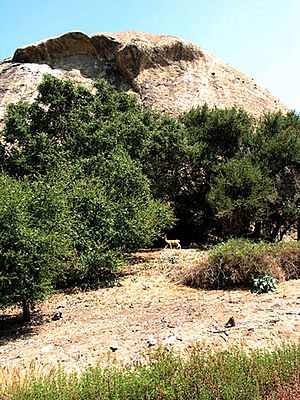Eagle Rock (formation) facts for kids
Quick facts for kids The Eagle Rock |
|
|---|---|

The Eagle Rock
|
|
| Location | Eagle Rock, Los Angeles, CA |
| Area | Northeast Los Angeles |
| Designated | November 16, 1962 |
| Reference no. | 10 |
Eagle Rock is a huge, dome-shaped rock formation in Los Angeles. It has a special shape that looks like an eagle flying! The neighborhood where the rock is located, Eagle Rock, is actually named after this famous rock. It's so big and easy to see from the Ventura Freeway, that millions of people recognize it. This amazing rock is also known as L.A. Historic-Cultural Monument No. 10, meaning it's a very important landmark in the city.
The Story of Eagle Rock
Eagle Rock is a large rock made of sandstone. It was formed millions of years ago by hot springs! Long ago, Spanish settlers called it "La Piedra Gorda," which means "Fat Rock." But people have been calling it Eagle Rock, or just "The Rock," since at least 1888. The very first drawing of La Piedra Gorda was made by an Austrian prince named Ludwig Louis Salvator. He published his drawing in a book in 1878.
Ancient Times and Legends
Hundreds of years ago, the Tongva people lived in the caves at the bottom of Eagle Rock. They used the rock as a perfect lookout spot to see far across the land. It's also said that a famous bandit, Tiburcio Vasquez, might have hidden in these same caves in 1874. In the early 1900s, people even held Easter services on top of the rock!
Protecting the Rock
Eagle Rock became a special "Historic-Cultural Monument" in 1962. This means it's a protected landmark because of its history and unique features. Even though it was named a monument, the rock didn't belong to the City of Los Angeles until 1995. That's when the City bought it for $700,000 to make sure it would be preserved for everyone to enjoy.

